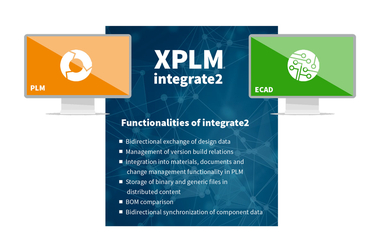In addition to software, electrics, electronics and automation are making an ever greater contribution to creating value in almost every manufacturing company. At the same time, customers increasingly expect individually designed product variants. Time to make use of a solution that offers transparent, consistent information management for the development of complex mechatronic products.
Sound familiar? Then have a look at our direct integrations of all common ECAD tools into established product lifecycle systems (PLM). Freeing your designers from annoying, time-consuming tasks, they can work more productively since the integrations manage, version and automatically process all of your engineering information into a single data model precisely tailored to your needs. On top of that, it supports coordination processes, approvals and changes by means of defined workflows into which all relevant information is fed. Our solutions have gained wide acceptance, not least because they allow developers to manage their data quickly and easily from within their familiar CAD environment.
Taking this one step further, the combination of our integrations with a PLM system forms the optimal basis for implementing trending technologies, such as networked production using IoT-based edge and data management or data-driven services.
Your information centre: Proactive, reliable and transparent
Our solutions offer comprehensive support at the start of a new project. Whether created from scratch or by replicating a previous project. Templates for entire projects or sub-areas are provided so that the integration and PLM map the usual working method of your developers 1:1.
When saving product data in the PLM, the integration ensures that the data is clearly named and properly stored in the correct place. It creates a data model in line with your definition and automatically adapts attributes to the new project. Saving can trigger defined actions, such as creating a new version. This in turn prevents accidental overwriting of existing data.
Furthermore, neutral formats for production and parts lists can be generated from native data. The integration first checks parts lists for completeness, comparing current parts lists with the previous version. The integration also generates output files by combining content together in the specified formats at the designated location and, if necessary, zipping it. Versions of related product data are linked so that any dependencies are clear.
Consistent material masters ensure the use of valid components
Items for components can be created in both the PLM system and the ECAD tool. The integration checks and updates the item master data when the parts list is generated if newly created components are used. During synchronisation, all adjustments are taken into account and made available to the developers.
During the development process, sophisticated search mechanisms simplify and accelerate the process of finding components, especially if the material masters are classified. The integration supports component classifications when synchronising between PLM and the ECAD library. This increases the reuse of components once they have been approved and avoids the creation of duplicates.
Electrical engineering processes
Our solutions can help with electrical engineering development, for example by generating the parts list as well as outputs such as connections lists, terminal strips from the circuit diagram, cable harnesses, etc. If, for example, terminal strips or cables are produced by external suppliers, the integration ensures that the required information is output in a format that can be read by the machines.
Working hand-in-hand with manufacturing and purchasing
Especially in the case of E/E engineering, continuous flow of information to adjoining departments such as purchasing and production is of particular importance due to the extensive nature of the parts lists. An integration between PLM and ERP systems is often used for the electronic transfer of project data and the cross-functional comparison of the material master data. eine bedeutende Rolle. Für die elektronische Übergabe der Projektdaten und der fachbereichsübergreifende Abgleich der Materialstammdaten wird häufig eine Integration zwischen PLM- und ERP-System eingesetzt.
The purchasing department receives complete bills of materials, which can then be used to quickly and easily determine a purchasing strategy, identify long-running products, etc. The bill of materials is converted into an engineering bill of materials (EBOM) for production data management, from which production generates and processes its manufacturing bill of materials (MBOM).
Once the EBOM and MBOM are linked, production is notified of any adjustment. Such mechanisms can be used to involve other departments in the development process from an early stage.








